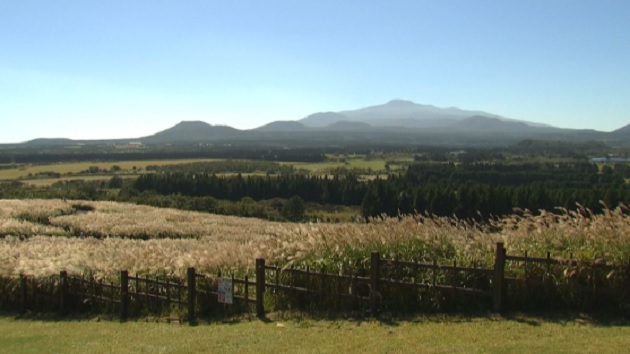
This week on Jeju: A to Z, Todd Thacker profiles a popular destination southeast of Jeju City called Sangumburi. As we’ll see now, this extinct volcanic crater covered in fields of light brown pampas grass is emblematic of autumn on the island.
The remarkably symmetrical crater of Sangumburi, an extinct volcano to the southeast of Jeju City, is a stunning ? and unique ? destination in more ways than one.
[Slug CG]
600 m crater resembles Hallasan Mountain’s Baengnokdam
Described as a kind of “natural stadium,” it is 600-meters in diameter and similar in size to Baengnokdam crater atop Hallasan Mountain. Around it are sweeping, light-brown fields of pampas grass, which grow several meters tall and are emblematic of the autumn and winter seasons on the island.
[Slug CG]
Pampas grass appears in Jeju-related films, TV, art, photography
Images of this grass appear in all sorts of artistic works related to Jeju, from films, TV dramas, and paintings by famous artists, like Jeju-born painter Byun Shi-ji, and nature photographer Kim Young-gap’s panoramic long-exposures.
[Slug CG]
Carefully monitored habitat for 400 plant and animal species
The crater and area is also a windfall for scientific research. Its densely packed habitat is home to about 400 species of plants and animals.
And though tourism and the environment usually are at odds, Sangumburi is carefully monitored. The hundreds of thousands of people who visit every year thus have a minimal impact on the site, while maximizing their appreciation for this Natural Monument.
[Slug CG]
Breathtaking vistas from crater rim
From atop the crater on a clear day, you can enjoy views of the ocean to the north, Seongsan Sunrise Peak to the east, and of course the breathtaking profile of Hallasan Mountain to the west ? all framed with the swaying pampas fields.
[Slug CG]
Todd Thacker
Sangumburi isn’t the only place on the island to capture iconic images of Korea’s autumn pampas grass, but it might just be the most picturesque.
Todd Thacker KCTV





